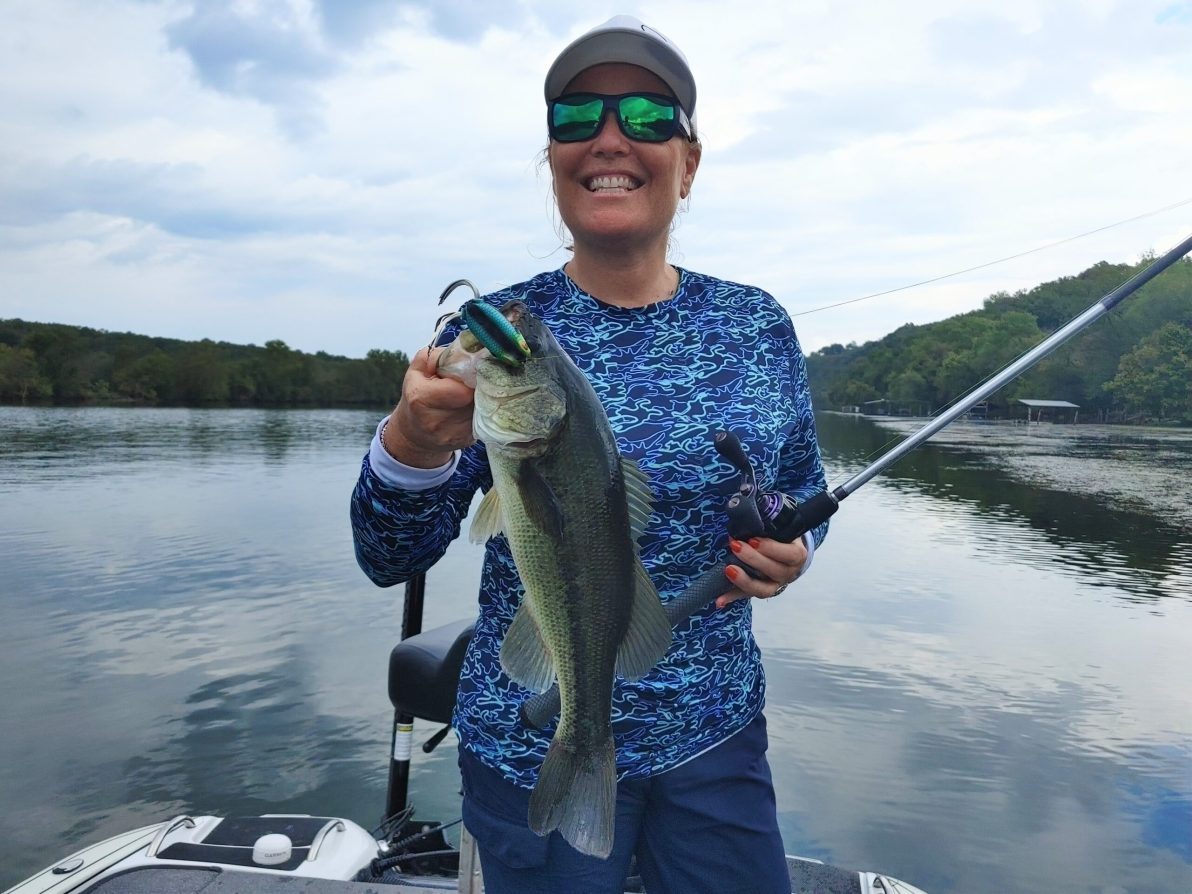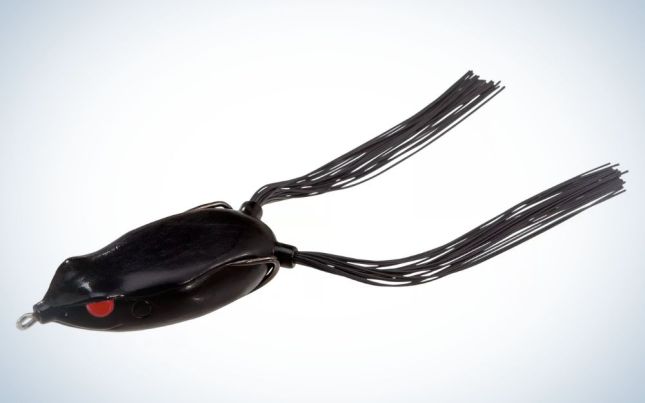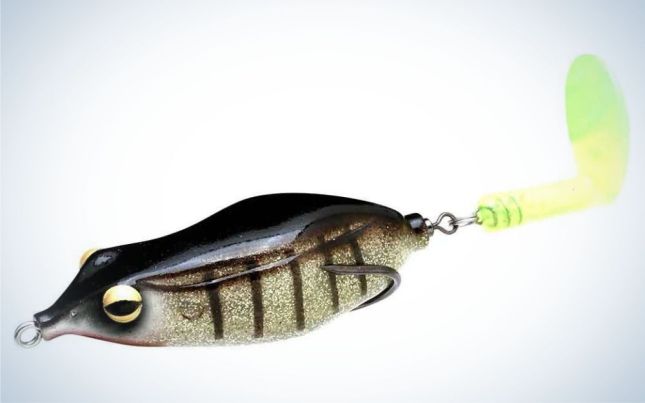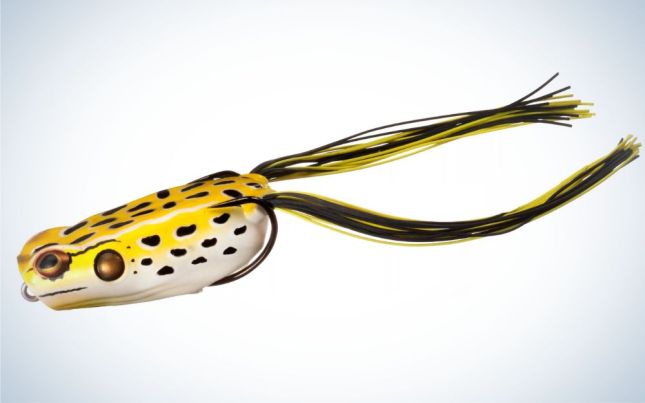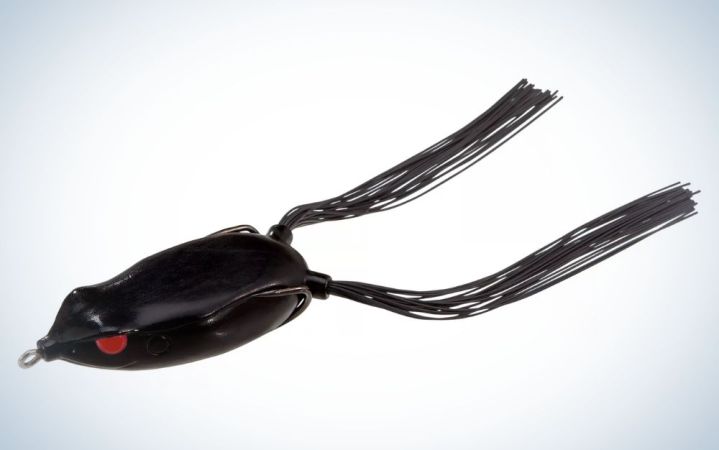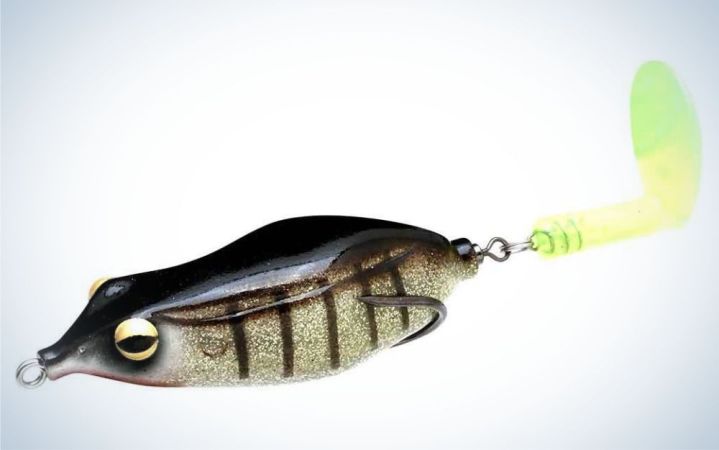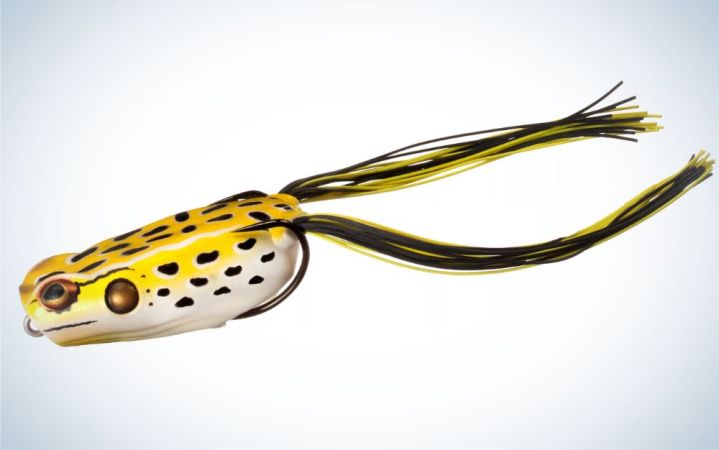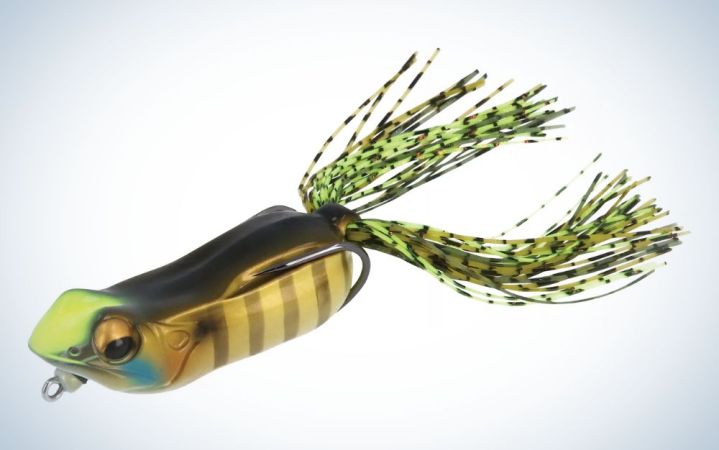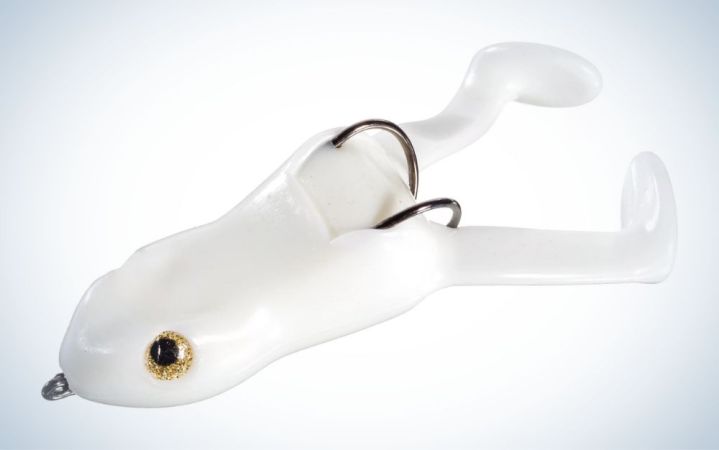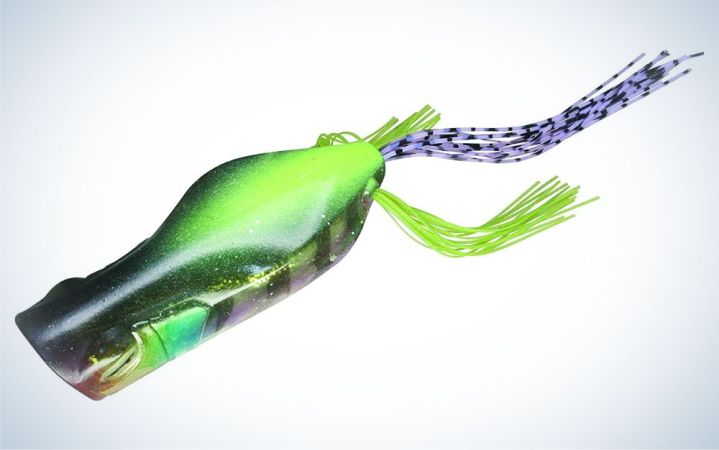We may earn revenue from the products available on this page and participate in affiliate programs. Learn More ›
At the turn of this century, the best frog lures for bass were whichever ones you could get your hands on. We had limited options for fishing heavy vegetation with anything but the most basic amphibians. While some produced strikes and resulted in landed fish, most of these lures were primitive—with subpar hooks, limited color schemes, and poor overall design.
Then two things happened that put the frog industrial complex into overdrive: First, braided line became more widely available and more consistently used. That meant that strikes that previously didn’t result in fish catches were now more likely to end in success. Second, professional angler Dean Rojas of Arizona showed that frog lures weren’t just for heavy vegetation, and weren’t only effective in the warmest temperatures. Rojas relied on a Boze Sumo Frog from Japan for a near win at the 2004 Bassmaster Classic on South Carolina’s Lake Wylie, and then worked with SPRO to develop the Bronzeye Frog. With that product introduction, the average angler could buy a frog that walked easily, did not take on water, had superior Gamakatsu hooks, and came in a wide range of colors at a reasonable price.
Rojas showed that these lures were much more versatile and reliable—and of course, fun—than their predecessors. After that, other manufacturers stepped into the arena. Some made products that mimicked SPRO’s, while others branched out into different designs, new colors and sizes, and all sorts of applications. Now it’s possible to skip a frog under a dock, pull a giant bass out of the thickest grass, and tempt bedding fish like never before.
I attended the Bassmaster Classic Rojas nearly won with a frog, and since then I’ve been addicted to frog fishing in my home waters of the Potomac and throughout the country’s best bass fisheries. Here are some of the best frog lures I’ve fished.
- Best Overall: SPRO Dean Rojas Bronzeye Frog
- Best for Covering Water: Teckel Sprinker
- Best Popping Frog: Booyah Poppin Pad Crasher
- Best Finesse Frog: Deps Slither K
- Best Large Frog: Megabass Big Gabot
- Best Toad-Style Frog: Stanley Top Toad
- Most Versatile: Jackall Gavacho
How I Chose the Best Frog Lures
I’ve been a frog fanatic for a long time—indeed, the Classic where Rojas made his mark was the first one I attended as a media member—and these days my frog box (or boxes) overfloweth. While I travel around the country and also internationally to fish for bass, my home waters are the Potomac River, which is a grassy bass hideaway where there are times when you can’t fish anything but a frog or a heavy flipping weight. Accordingly, I always have at least two or three frog rods ready to go. And with the proliferation of snakeheads (a species that loves frogs more than bass do at times), I’ve learned which models are most durable.
Best Frog Lures: Reviews and Recommendations
Best Overall: SPRO Dean Rojas Bronzeye Frog
Key Features
- Lengths: 90 mm (3.5 inches), 65 mm (2.5 inches), and 60 mm (2.3 inches)
- Over 40 different colors from basics to forage-specific
- Soft, narrow body design
Pros
- Great range of colors
- Walks easily
- Skips well under overhanging cover
- High quality 2X Gamakatsu hooks
Cons
- After a number of fish sometimes takes on water

This is the frog that truly changed the game for the vast majority of bass anglers, and while SPRO has enhanced the line with popping versions and other noisemakers, if you’re only going to get one frog, this is the one. Everything about it is premium, from the extra-strong Gamakatsu double hook that stands up to your hardest braided line hook sets, to the line tie, which is welded closed so that your braid will never slip out.
The living rubber legs match the many colors and are left extra-long so that you can trim them to your liking—some anglers like them short or uneven for better walking abilities. Anglers just starting out should favor black, white, and maybe a frog pattern, but some of the all-time great colors from SPRO include Killer Gill, Nasty Shad, and Red Ear. With those, you’re not just limited to imitating frogs and toads, but also all manners of baitfish.
When you’re learning how to fish a frog bait, one of the first skills is walking a frog. Creating the enticing side-to-side dance is exceptionally easy with the SPRO Bronzeye, which makes it one of the best frog lures for beginners and seasoned pros.
Best for Covering Water: Teckel Sprinker
Key Features
- Length: 3-inch body, and 4 inches with tail
- Weight: 5/8 ounce
- Flush-mounted double hook
- More than a dozen colors
Pros
- Built on Teckel’s narrow hollow body
- Tail spins at any speed
- Replacement tails available and easy to install
Cons
- Other options may be better for slow retrieves
Lure-building mastermind Hideki Maeda of Japan has long designed great innovations for other companies, but with his own company, he’s been able to let his frog obsession run free. The results have been phenomenal, with all sorts of noise making amphibians hitting the market for different circumstances. None of the others, however, have proven as popular (or have produced as many tournament big bass awards) as the Sprinker. It adds a tail like that found on a Whopper Plopper to the frog body. Reeled at any consistent speed, the tail rotates on a free-spinning swivel, and creates a sound that calls fish from afar.
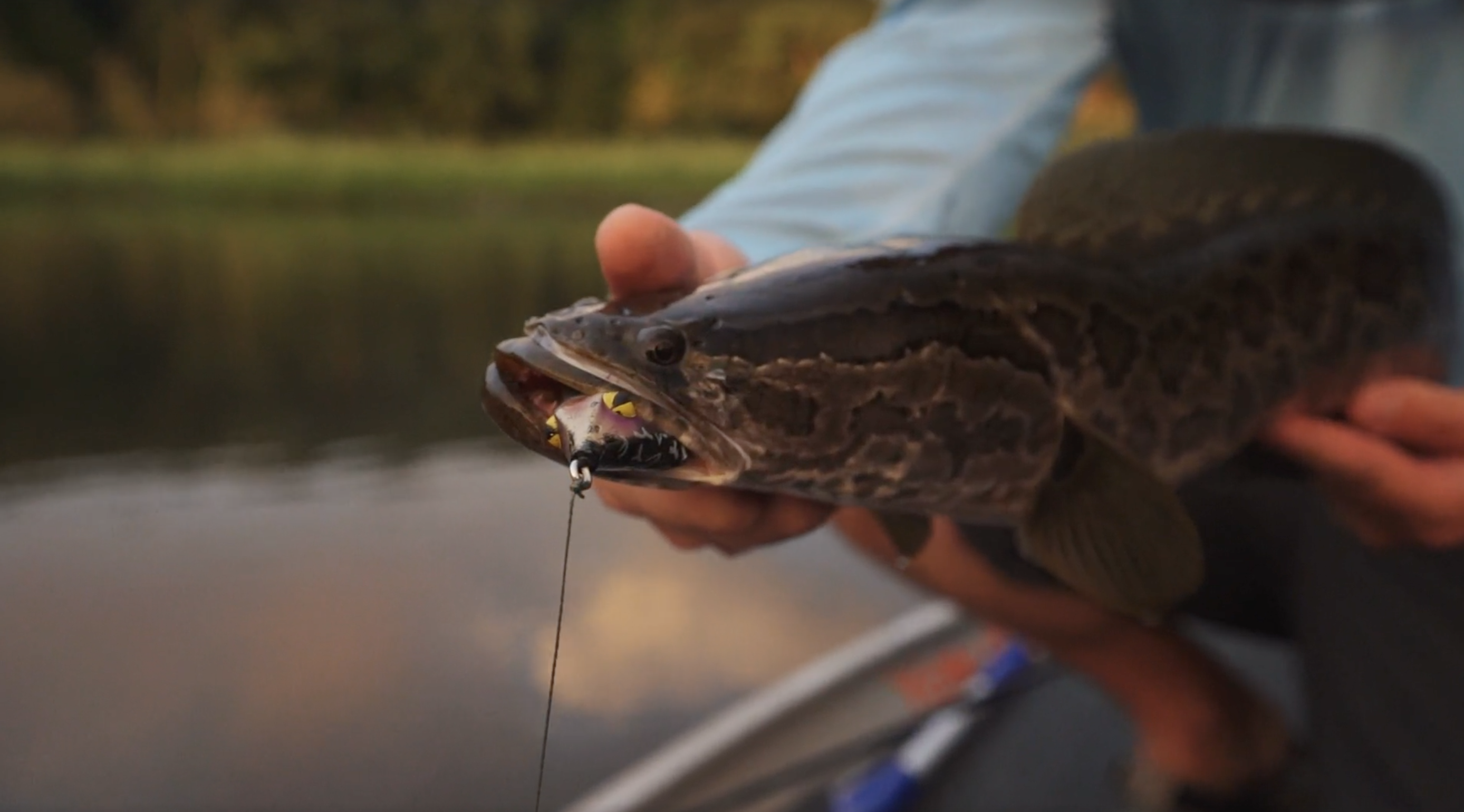
When it first came out, and was in limited supply, covetous anglers were paying multiples of the MSRP to get one, but now they’re readily available at market prices. This lure is one of the easiest to fish effectively—just cast it out and reel it back—and while the plastic is soft it is also super-durable, so even after a lot of fish it continues to run true without taking on water.
One tip is to buy extra tails because short strikers will rip them off. Luckily, the replacements thread easily onto the screw lock for easy repair.
Best Popping Frog: Booyah Poppin Pad Crasher
Key Features
- Length: 2.5 inches
- Weight: .5 ounce
- Cupped popping mouth
- Soft-but-durable plastic collapses on the strike for better hookups
Pros
- Can be manipulated to make heavy “bloops” or slight disturbances, and everything in between
- Solid range of colors
- Very high hookup percentage, especially on short strikers
Cons
- Not as many colors as some other brands
Not a lot of pro anglers talk about Booyah’s frogs, but a lot secretly stow them in their boats. That includes this popping version, which can move a ton of water or just a little, depending on what the angler does with their rod. Typically a popping frog demands a slow presentation, and this one does well in that instance, but it can also be used at moderate or fast speeds, and at each speed, it can be made to produce different sounds. Accordingly, anglers who hear the “Rice Krispies” noise of panfish popping on the underside of lily pads can replicate that, while those who want to make the lure more froglike can achieve that equally well. The plastic is soft, and even hesitant strikers seem to end up with lip jewelry. In addition to the mainstream colors, the Shad Frog color is exceptional during the shad spawn or in the fall, and the Pumpkinseed pattern is fantastic when bass are patrolling bream beds.
Best Finesse Frog: Deps Slither K
Key Features
- Length: 2.25 inches
- Weight: 3/8 ounce
- Rabbit fur tail
- High quality double frog hook
- 12 colors
Pros
- Extra soft construction and superior engineering translate into high hookup percentage
- Easy to manipulate
- Despite being small, still heavy enough to cast into the wind
Cons
- Softness makes it less durable than some other frogs
Japan’s Deps is known for offering unique, premium products, and this little frog is just that. It’s small, but still packs enough of a profile and indentation on thick grass to attract attention. I was amazed at how easily it walked right out of the package, and while I’m used to silicone or rubber leg material, the rabbit fur is every bit as good. Even when the frog itself is sitting still, the tail continues to undulate and it doesn’t seem to mat up if put away wet. There are times when a standard-sized frog is too much for finicky fish, and that’s when you want the Slither K. This frog does cost a little bit more than some other models, but the performance is worth the price. If you like this line, you should also check out their Buster K popping frog.
Best Large Frog: Megabass Big Gabot
Key Features
- Length: 3 inches
- Weight: .75 ounce
- “Catamaran mouth” helps stability, while also allowing the frog to spit and walk
- Custom-designed hook bend and wire diameter
- Matching skirt tails
Pros
- Casts a mile
- Can be made to walk and spit with ease
- Good range of colors, including several distinct shad and panfish patterns
Cons
- Priced a little higher than many other frogs
When bass are feeding on larger-than-average prey, or anglers need a kicker fish to close out a tournament, sometimes it pays to go to a larger model. Big baits are also useful when bass are under thick mats, and a slightly heavier bait is needed to get their attention.
Megabass, another Japanese purveyor of distinctive tackle, realized that and introduced the impressive Big Gabot. It’s still not a huge bait by bass fishing standards—smaller than many deep diving crankbaits and topwaters—but it’s larger than the average hollow-bodied frog. Nevertheless, it’s still not as big as some others like SPRO’s King Daddy. While it’s good for imitating an amphibian, it really shines when bass are eating bluegills or other small fish, as it has colors meant to imitate perch and bluegills, as well as multiple kinds of shad.
Best Toad-Style Frog: Stanley Top Toad
Key Features
- Length: 4 inches
- Over two dozen colors
- Hollow body and hard-paddling feet
Pros
- Unlike most toads, can be fished at ultra-slow speeds or even stopped
- Collapsible body leads
Cons
- Needs a separate hook (included in some packages)
While Stanley may not have introduced the first “reeling toad,” their Ribbit contributed mightily to the popularization of the category, and it still continues to catch lots of bass today, thanks to its paddling feet and easy-to-rig body. Now they’ve taken that same toad concept and married it to a hollow body, which means that it retains all of a reeling toad’s value at high speeds, just with better hookup percentages.
Meanwhile, it can be fished slowly, or even stopped, without sinking (that’s a huge advantage). The Top Toad, which also comes in a popping version, works best with Stanley’s 5/0 Double Take Hook, which is included in some packs. Solid black is a great all-around choice, but there are a lot of different versions of greens and coppers that better imitate frogs, toads, and panfish. One sleeper color is Cricket Frog, which features a light blue bottom. I’ve had a lot of success with this pattern on tidal rivers and in tannic water.
Most Versatile: Jackall Gavacho
Key Features
- Length: 2.75 inches
- Weight: ⅔ ounce
- Six colors
Pros
- Easy to work
- Casts a long distance
- Covers many situations
Cons
- Doesn’t come through cover as well as a walking frog
There aren’t many times I don’t have a Gavacho tied onto my line because there aren’t many situations where it doesn’t excel. If I’m fishing a pad field, I can bring the bait into an opening and walk it in place. If there’s some chop on the water I can pop the frog. I have no problem quickly walking it down a weed edge. The only time it doesn’t shine is in really thick vegetation because the cupped face doesn’t come through cover as cleanly as the pointed head of a walking frog.
I also like that working the Gavacho takes very little effort, and the slim profile means I get more eats with fewer short strikes. The hooks on it are the right thickness, so they won’t bend out when you’re winching a fish from the slop, but they’re thin enough that they still penetrate easily. Another design feature that aids in hookup ratio is the soft body, which easily collapses and exposes the hooks. —Scott Einsmann
Other Great Frogs
A great frog for when bass are short striking and you need to downsize to stick them.
The Honker can be walked or run like a buzzbait because instead of rubber legs it has tiny Colorado blades that spin and gurgle when retrieved.
The Z-Man Goat ToadZ is made from Elaztech, so it floats and it’s extremely durable. The fluttering legs put out a nice bubble trail for covering water.
The Bully Wa is one of the best walking frogs available. It has a tight side-to-side walk that’s easy to create, and it comes with stout hooks that stand up to the heaviest cover.
Frogging Gear
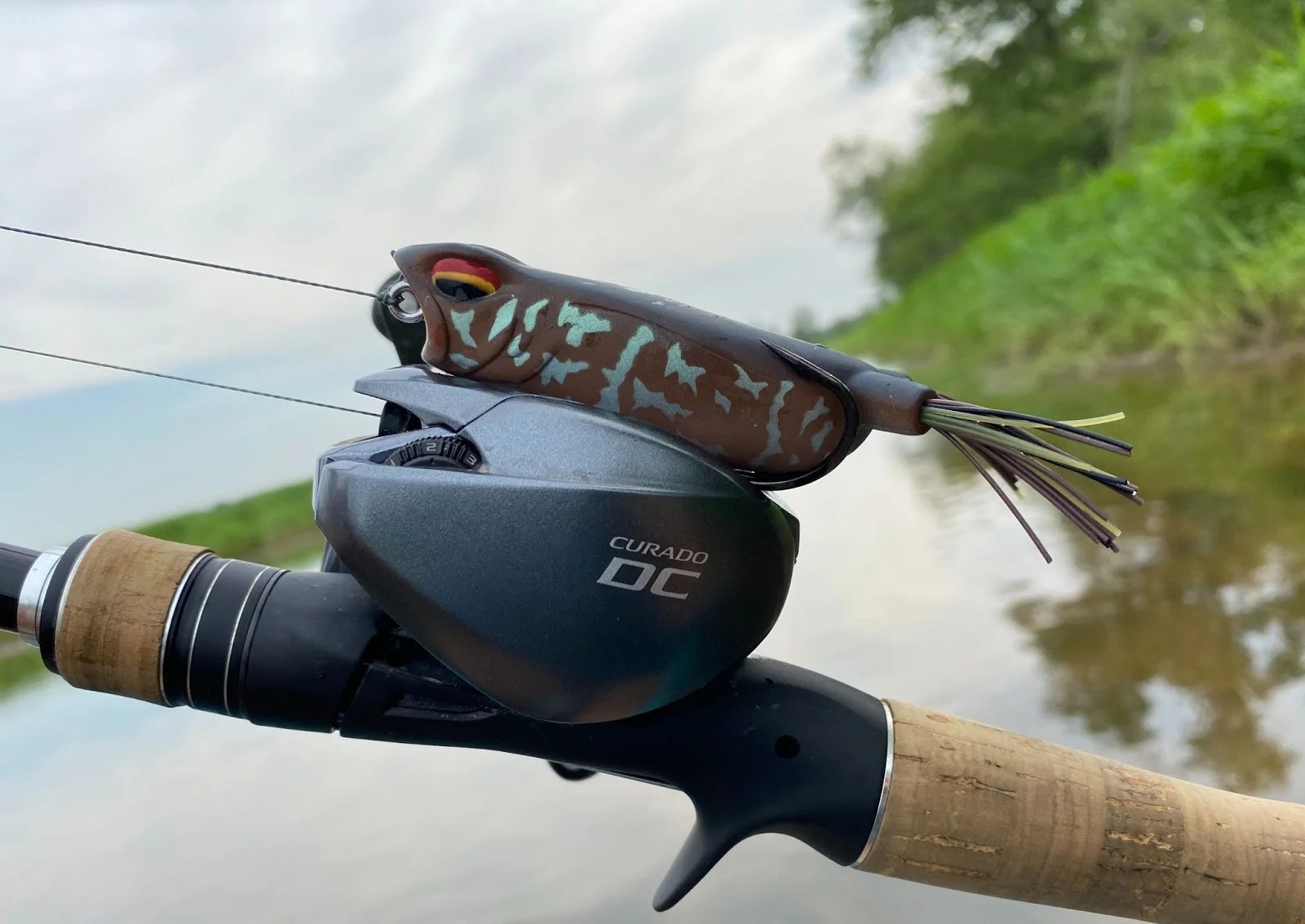
You can’t throw an unweighted senko and a frog on the same gear. It pays to have a dedicated setup for frogging. Here are recommendations on the right gear to use for fishing frogs.
Line
Frogging isn’t a finesse strategy, and you need a heavy line to power fish from thick vegetation. Most anglers use a 65-pound to 80-pound braid straight to the lure. Many of the best braided lines work well, but Power Pro Maxcuatro is a stand out.
Rod
The best frogging rods have a fast action and a heavy to extra heavy power. Most anglers will prefer a 7-foot to 7.5-foot rod.
Read Next: Best Bass Rods
Reel
A reel with a high gear ratio helps to quickly pick up slack or burn a frog in for the next cast. One of the best frogging reels is the Shimano Curado DC.
Read Next: Best Baitcasting Reels
Things to Consider When Buying Frog Lures

Cover
In open water, frogs can have a lot more moving parts, but in heavier cover, and especially where there’s lots of fibrous grass, swivels and pivot points can get matted up. Most of the hollow-body frogs and reeling toads do well in matted grass, lily pads, and even fields of debris, but the most streamlined baits do the best. Each time you have to clear grass off your lure, you miss out on an opportunity to keep that bait wet and entice a strike.
Forage
Bass certainly feed on frogs and toads, but they’re omnivorous, so don’t merely think of “frogs” in those terms. This is a category of lure that does well to replicate terrestrials, panfish, and shad as well. Think about what you’re trying to imitate not only when you consider what sound your frog will produce, but also when selecting key colors.
Speed
When covering massive expanses of water, you’ll want a frog or toad that draws fish from their recesses. For example, the Sprinker frog can be worked quickly down a weed edge or over open water. But when targeting bass on hyper-specific pieces of cover, you’ll want one that’s at its best when fished slowly. Here, a walking frog like they Bronzeye frog is ideal because it moves side to side rather than straight forward. When you get really good with a walking frog, you can walk it without moving it forward.
FAQs
While the best frog fishing typically doesn’t occur until the post-spawn, some dedicated anglers use them in the pre-spawn and for bedding bass. In those situations, don’t expect many bites, but the ones that you get will likely be from bigger than average fish.
There is no reason to use any line but braid—typically in 50- or 65-pound test—when fishing topwater frogs. That’s especially true in vegetation, where the thin diameter and lack of stretch helps anglers winch big fish out of heavy cover.
Many experts claim that frog color doesn’t matter much, and they exclusively use either black or white frog lures. Other experienced anglers believe that since they’re topwater lures, only the belly matters. It pays to have a variety of lure colors for times when fish get finicky—or when they’re feeding on specific prey like sunfish, perch, or shad.
Final Thoughts on the Best Frog Lures
There’s no more exciting way to fish for bass than with the best frog lures, but at the same time it’s a tactic that can be exceptionally frustrating. They’ll often swipe at the lure or smack it halfheartedly, and because much of the combat takes place in heavy cover, there are invariably lost fish. Nevertheless, in just two decades the industry has treated anglers to an ever-increasing range of frog options—one that grows constantly. Get some braid, get a fairly stiff rod, gather up some of the top frog options, and then figure out which ones work best on your home waters.
